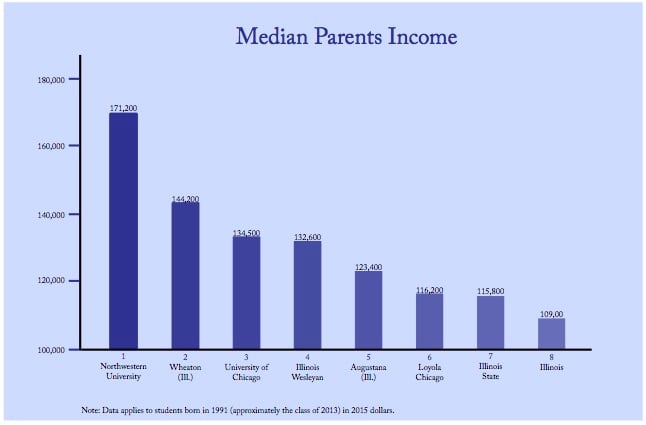New York Times report reveals income imbalance among Northwestern students
Data from report by The New York Times’ The Upshot.
January 19, 2017
About two thirds of Northwestern students come from families in the top income quintile, according to a report by The New York Times’ The Upshot published Wednesday.
The report includes analysis of economic diversity at several colleges and universities across the United States and is based on data pulled from millions of anonymous tax filings and tuition records. It compares Northwestern with peer institutions in economic diversity and average income after graduation. The report analyzed more than 2,000 institutions.
The median household income for students at NU is $171,200 — the 81st highest average income percentile of the institutions included in the study. Fourteen percent of students come from families who make $630,000 annually, which is the minimum yearly income for the top 1 percent of earners.
Only about 3.7 percent of students come from households earning $20,000 a year or less, placing them in the bottom quintile.
University spokesman Al Cubbage said the University is working to improve economic diversity on campus. In March 2016, NU removed loans for incoming students as part of changes to its financial aid program. The percentage of students who are eligible for Pell Grants — a federal grant given to low-income students — has steadily increased over the past three years, with just under 17 percent of the class of 2020 being Pell-eligible, compared to 12.5 percent of the class of 2018.
“The University certainly continues its efforts to diversify our undergraduate populations economically,” Cubbage said. “The initiatives we’ve taken — the no loan package, the increased financial aid — are making an impact.”
The University has a goal to make 20 percent of students Pell-eligible by 2020.
Associated Student Government President Christina Cilento said she met with University President Morton Schapiro and Patricia Telles-Irvin, vice president for student affairs, on Wednesday to discuss ways to improve economic diversity and support for low-income students on campus. ASG plans to submit a list of recommendations to Telles-Irvin to remove financial obstacles, including high textbook costs and student organization membership fees, Cilento said.
The SESP senior said focusing career advising on the unique needs of low-income and first-generation students is important to helping them succeed beyond graduation and enter fields that may otherwise be restrictive due to graduate school and work costs.
“It’s common knowledge on campus that Northwestern is a pretty wealthy institution, and a decent amount of our student body comes from high-income backgrounds,” Cilento said. “So providing greater academic advising and resources for … low-income students is definitely key.”
Compared to peer institutions, Northwestern students demonstrate relatively higher socioeconomic mobility, with 55 percent of students from the bottom income quintile advancing to the top income quintile after graduation. Of the 64 institutions classified as “elite colleges” in the report, including Northwestern, the Ivy League schools and several other similarly ranked schools, Northwestern ranked 18th in that dimension.
Steffany Bahamon, president of the Quest Scholars Network, said she was optimistic about the direction Northwestern is going. Although low-income and first-generation students can feel isolated at Northwestern, the McCormick senior said she can see the campus community working to improve economic diversity and support.
“There’s a real push, not just from Quest and SES, but from everywhere on campus,” Bahamon said. “There’s a lot of support for the cause of low-income and first-generation students. And who knows? Maybe we’ll end up beating the statistics on the report one day.”
Email: [email protected]
Twitter: @matthewchoi2018


